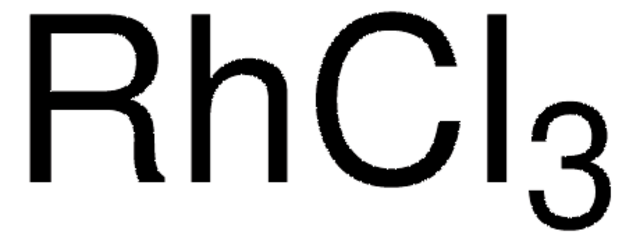463779
Ruthenium(III) chloride hydrate
99.98% trace metals basis
Synonym(s):
Trichlororuthenium hydrate, Ruthenium trichloride
About This Item
Recommended Products
Quality Level
Assay
99.98% trace metals basis
form
powder and chunks
reaction suitability
reagent type: catalyst
core: ruthenium
impurities
≤250.0 ppm Trace Metal Analysis
SMILES string
O.Cl[Ru](Cl)Cl
InChI
1S/3ClH.H2O.Ru/h3*1H;1H2;/q;;;;+3/p-3
InChI key
BIXNGBXQRRXPLM-UHFFFAOYSA-K
Looking for similar products? Visit Product Comparison Guide
General description
Application
- As a precursor to prepare ultralow Ru loaded graphene aerogel that exhibits electrocatalytic performance in the hydrogen evolution reaction (HER), oxygen evolution reaction (OER), and oxygen reduction reaction (ORR).
- As a dopant to prepare Ru-doped TiO2 electron transport layer for mesoscopic perovskite solar cell by spin-coating technique. This helps to enhance photoconversion efficiency and air stability.
- To fabricate ultra-uniform Ru nanocluster catalyst via small-molecule self-assembly pyrolysis method. These catalysts exhibit excellent hydrogen evolution activity in Zinc air batteries under all pH conditions.
Other Notes
Signal Word
Danger
Hazard Statements
Precautionary Statements
Hazard Classifications
Acute Tox. 4 Oral - Aquatic Chronic 2 - Eye Dam. 1 - Skin Corr. 1B
Storage Class Code
8A - Combustible corrosive hazardous materials
WGK
WGK 3
Flash Point(F)
Not applicable
Flash Point(C)
Not applicable
Personal Protective Equipment
Choose from one of the most recent versions:
Already Own This Product?
Find documentation for the products that you have recently purchased in the Document Library.
Customers Also Viewed
Articles
Hydrogen is one of the most important resources in providing food, fuel, and chemical products for our everyday life. Sustainable catalytic hydrogen production from bioethanol has gained significant attention in recent years due to globally diminishing fossil fuel supplies, which have necessitated the search for new chemical feedstocks.
Our team of scientists has experience in all areas of research including Life Science, Material Science, Chemical Synthesis, Chromatography, Analytical and many others.
Contact Technical Service












